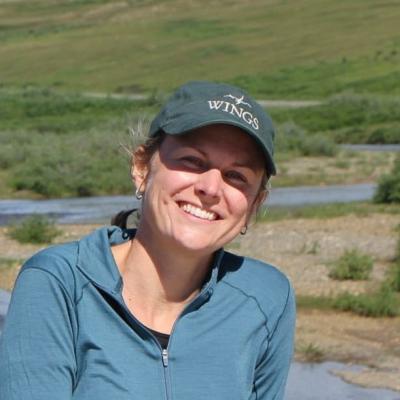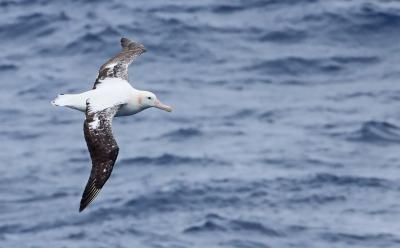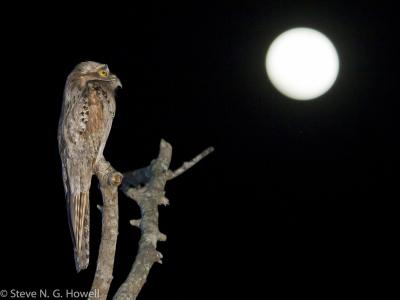Mexico: Veracruz
Migration is a Moving Experience
-
Sep 29 to Oct 7 2025
Steve Howell
2025
Single Room Supplement $300
2025
Single Room Supplement $300
Spanning from the warm waters of the Gulf of Mexico to the snow-capped volcano of Mount Orizaba, Mexico’s highest peak at 18,490 feet elevation, the state of Veracruz is home to an extremely diverse avifauna. Add to this the spectacle of fall migration, especially the world-famous ‘River of Raptors,’ and our short trip to sample this area makes for a memorable and remarkable experience.
Based out of only two hotels, we’ll divide our time between the coastal lowlands, where the local birds will compete for our attention amid the migrants, and the highlands of the Sierra Madre Occidental and Central Volcanic Belt, where coffee fincas grade into cloud forest and then cool fir forests on the higher slopes. From the recently split Veracruz Wren in coastal cactus to endemic Red Warblers flaunting their color in highland conifers, from tens—or even hundreds—of thousands of Broad-winged Hawks in a day to reclusive Blue-capped Motmots and Collared Towhees, this new trip is a great chance for a wonderful short getaway to the magic of Mexico.
Day 1: If time permits, after arrival we may do some birding on our hotel grounds, where species include Golden-fronted Woodpecker, Great Kiskadee, Yellow-winged Tanager, and even the recently established Monk Parakeet! Night in Veracruz.
Veracruz with Steve Howell was I believe my 12th Wings trip and I can easily say it was the birdiest. Whether it was the Broad-winged Hawk river in the sky, warblers in every tree and bush or 100’s of ducks fighting the wind over the ocean, there were so many birds. Mexico is a bird funnel for North American migrants in the fall. That said, it all depends on the weather, and we lucked out this year. - Kent A
Days 2–3: As with any migration tour, our daily plans will depend on the weather, but we’ll be checking beaches and coastal migrants traps for shorebirds and landbirds (sometimes including a pleasant variety of warblers, such as Mourning and Hooded), as well as relaxing in chairs to watch the raptor flights, which this early in the season are dominated by Broad-winged Hawks, with smaller numbers of Mississippi Kites, Turkey Vultures, and sundry other species. Resident birds of interest include Aplomado Falcon, Double-striped Thick-knee, Fork-tailed Flycatcher, and the recently split endemic Veracruz (née Rufous-naped) Wren, along with so-called South Texas specialties such as Brown Jay, Altamira Oriole, and Plain Chachalaca. Nights in Veracruz.
Days 4–7: We’ll spend another morning on the coastal plain and after lunch move inland to the state capital of Xalapa for four nights. From our base here we can explore pine-oak forest with flitting warbler flocks and skulking brushfinches; shady coffee-finca forest with Blue-capped Motmots and Bronze-winged Woodpeckers (plus a great diversity of colorful butterflies); plateau desert with thrashers, hummingbirds, and sparrows; and even high-elevation fir forest and bunch grass with resident (!) Golden-crowned Kinglets and the local endemic Striped Sparrow. Relict areas of drier grassy and scrub habitat are home to Mexican Sheartail, Botteri’s Sparrow, and the recently split Grass Wren, and anywhere we go we could run into southbound migrants, perhaps an Olive-sided Flycatcher sallying from a tall cactus, or a Canada Warbler sharing its tree with resident Crescent-chested and Olive Warblers. Nights in Xalapa.
Day 8: After a final morning of birding near Xalapa we’ll head back to the lowlands, stopping for any hawk flights, which by now will contain more Turkey Vultures and Swainson’s Hawks than only a week ago, and reaching our hotel in good time to rest and pack before a fine last dinner. Night in Veracruz.
Day 9: Depending on flight times, there may be opportunity for a little morning birding before transfer to the airport and flights homeward, after a rich and fun week exploring a tiny slice of Mexico.
Note: The information presented here is an abbreviated version of our formal General Information for Tours to Mexico: Veracruz. Its purpose is solely to give readers a sense of what might be involved if they take this tour. Although we do our best to make sure that what follows is completely accurate, it should not be used as a replacement for the formal document sent to all tour registrants, whose contents supersedes any information contained here.
ENTERING MEXICO: Mexico requires a valid passport for entry by US citizens. Citizens of other countries may need a visa and should check their nearest Mexican embassy. Your passport should be valid for at least six months after the date the tour ends. Tourist cards are required and are obtained upon entry at the border customs.
HEALTH: The Centers for Disease Control and Prevention (CDC) recommends that all travelers be up to date on routine vaccinations. These include measles-mumps-rubella (MMR) vaccine, diphtheria-tetanus-pertussis vaccine, varicella (chickenpox) vaccine, polio vaccine, and your yearly flu shot.
You can review the latest CDC advisories here.
PACE OF THE TOUR: As with all tours in the tropics, we’ll try to be in the field close to dawn which means about 6:15 a.m. The pace of each day varies somewhat with this tour: All breakfasts are at our hotel, typically picnic-style with a selection of yogurt, granola, fruits, and breads, plus juice and tea/coffee. Because of the high temperatures in the lowlands, most lunches are at restaurants, although we may have one or two picnic lunches if weather permits. All dinners are at restaurants. Walking is mostly along roads and wide trails that are level to gently sloping, with the option for some short stretches of steeper gradients. The highest elevation where we will be is around 10,000 feet (and walking slowly), but most of the time we’ll be around or below 7500 feet. Within the itinerary there are several afternoons where participants have the choice to relax at the hotel while others might make repeated visits to raptor-watching hotspots.
CLIMATE: Mexico’s climate is extremely variable. The lowlands around Veracruz, Cardel and Los Tuxtlas are humid and hot. Daytime highs could reach the mid-90°s F while in the lowlands. The highlands around Xalapa will be more comfortable, but early mornings may be cool enough for a jacket and sweater (as cool as the 40°s F). Rain is likely, and we highly recommend your bringing a travel umbrella.
ACCOMMODATIONS: All hotels have enhanced cleaning and offer standard facilities. All have AC. All hotels should have wifi, though strength of signal ma vary. Hotel Mocambo in Veracruz has extensive grounds with birding potential, along with comfortable rooms, AC, and wifi. Hotel Fiesta Inn Xalapa is modern and comfortable with an excellent restaurant, wifi, and AC.
TRANSPORTATION: Transportation during the tour is by 15-passenger van/bus. All participants should have a window.
SMOKING: Smoking or vaping is prohibted in the vehicles or when the group is gathered for meals, checklists, etc. If you are sharing a room with a non-smoker, please do not smoke in the room. If you smoke in the field, we ask that you do so well away and downwind from the group, if possible.
TERMS AND CONDITIONS OF WINGS TOURS: Please take a moment to read the About WINGS Tours. This section contains important information about how we conduct tours, e.g., what is included in the tour price, refund and cancellation policies, pace of the tours, and other information that will help you prepare for the tour.
ADDITIONAL INFORMATION: A more complete General Information for Veracruz, Mexico, Tours will be sent to each registrant on receipt of their booking. Final information with instructions for meeting the group, hotel addresses, etc., will be mailed about three weeks before trip departure. Other news will be communicated as necessary. If you have any questions, please contact us.
2023 Narrative
In Brief: Our revival of this migration-centered tour was a great success, with a small group and fabulous birding, from quiet beaches to cool montane conifer forests. Whether it was dizzying kettles of thousands of hawks or a coastal fallout of migrants everywhere we looked (from American Bittern to Dickcissel to abundant Yellow-breasted Chats), the great diversity of birdlife kept us busy—but in a good way. From dust-bathing Northern Bobwhites to flitting Red Warblers; from local endemics such as Strickland’s Woodpecker, Blue-capped Motmot, and Bearded Wood-Partridge to 22 species of migrant warblers (plus six residents!) and Ferruginous Pygmy-Owls at every turn; from sun-downer beers to colorful butterflies in tropical forest; and from a calm sunny morning in high desert with singing thrashers to a blustery beach afternoon with hundreds of migrant waterbirds it was a very special week, away from the madness of the so-called ‘developed’ world. The great range of habitats produced almost 300 species in a week of unhurried birding, but all too soon it was over.
In Detail: Everyone arrived safely into hot sunny weather, with time the first afternoon for a little light birding near the hotel, where the recently established Monk Parakeets showed well, alongside Golden-fronted Woodpeckers, Great Kiskadees, and numerous tail-less Great-tailed Grackles. The intro meeting and dinner were followed by a good sleep. After an early breakfast, our first morning found us at a quiet beach road where swarm after swarm of migrating White-winged Doves passed over southward, along with flocks of Dickcissels and a scattering of other species ranging from White Ibis to Magnolia Warbler. Residents included some obliging Ferruginous Pygmy-Owls, both Common Black and Great Black Hawks, the endemic Veracruz [Rufous-naped] Wren, Black-headed and Cinnamon-bellied Saltators, and Rose-throated Becard, while migrants ranged from Mississippi Kites and countless swallows (4 species) to an elusive Alder Flycatcher and abundant Yellow-breasted Chats. The heat kicked in by mid-morning so we headed to the famous Cardel hawk migration watchpoint atop the Hotel Bienvenido, where Pronatura Veracruz is into its 33rd year of counting the world famous ‘River of Raptors.’ Our timing was good: we stepped into the river mid-stream and before lunch almost drowned in tens of thousands of Broad-winged Hawks (of 220,000 logged during the day!), along with spectacular kettles of Anhingas and sundry other species. After lunch and a welcome siesta we explored south of Veracruz City and, despite hordes of beach-going locals, we found beautiful Scissor-tailed and Fork-tailed Flycatchers side-by-side, along with a variety of waterbirds such as Fulvous Whistling-Duck and Bare-throated Tiger-Heron, plus some wonderful Double-striped Thick-knees and a stunning sunset—not bad for the first day!
Another early start took us to another beach spot, where we soon appreciated the potential for great daily variation in migration—today no White-winged Doves! But by poking around we found a nice variety of shorebirds, headlined by the steadily declining (thanks to humans) Collared Plover, plus Aplomado Falcon and a scattering of migrants. At another beach spot we enjoyed a tern roost with hundreds of Sandwich Terns among which we picked out 3 uncommon Common Terns, along with Black Skimmers and a Reddish Egret. The hot-weather trend continued so we adjourned once more to Cardel and got to watch the steady build up from no hawks to thousands, with kettles appearing and disappearing as if by magic. Most were Broad-winged as expected on this date, plus a handful of Swainson’s Hawks and a beautifully low and showy Zone-tailed Hawk, along with hundreds of American White Pelicans and Anhingas. In the afternoon we moved inland to the Chichicaxtle observation tower where, with a pleasing number of locals as well as visiting foreign birders, we watched thousands upon thousands of Broad-wings streaming and kettling over, among which we picked out some dark-morph birds plus a single Hook-billed Kite. The adjacent trees held migrant Baltimore Orioles, a Couch’s Kingbird, and a handsome Yellow-winged Tanager.
We had hoped on one of the lowland days for overnight rain to ground some migrants and—amazingly—that is what happened! Our morning at a marshy savanna area south of Veracruz produced an exciting mix of birds (100 species in 4.5 hours!) all over the place—from a remarkable total of 6 American Bitterns showing well to an undoubted underestimate of 80 Yellow-breasted Chats. Plus Wilson’s Snipes in the open, Blue Grosbeaks and Dickcissels on roadside grasses, numerous Ruby-throated Hummingbirds, and warblers, orioles, flycatchers, and vireos every few feet! Residents included singing Plain-breasted Ground-Doves, cryptic Double-striped Thick-knees, hunting Aplomado Falcons, and both Tropical (a recent range expansion) and Northern Mockingbirds. The mix of northern and southern species in this region was nicely exemplified by a male Northern Cardinal perched alongside a male Barred Antshrike! Then it was on to our base in Xalapa for the next four nights, at 1400 m elevation and within easy reach of varied highland and foothill habitats.
Our first highland day we began in cloud forest at Las Minas, where birding was good despite the sunny ‘tourist weather’—although that did mean things quickly got rather quiet. The first few hours, however, featured great audio of the very local endemic Bearded Wood-Partridge, plus flocks of warblers including Red and Crescent-chested, plus showy Gray-barred Wrens, handsome Emerald Toucanets, and stealthy Black Thrushes. Spectacular, low-flying White-throated Swifts entertained as the local Peregrine Falcons and Red-tailed Hawks circled overhead, a stunning male Elegant Euphonia burbled forth from his mistletoe hide-out, and Bumblebee and Garnet-throated Hummingbirds visited roadside flowers. Moving to higher elevation on Cofre de Perote we found the controversially split Transvolcanic Jay and the poorly known, highly local, and tiny-billed Strickland’s Woodpecker, as well as Collared Towhees, Striped Sparrows, more Red Warblers, and numerous ‘Southeast Arizona specialties’ such as Olive Warbler, Mexican Chickadee, and Yellow-eyed Junco. Not to mention those resident ‘Aztec’ Golden-crowned Kinglets—so we won’t.
The second highland day started in cool valley fog near Perote, but as if by magic the fog quickly dissipated to reveal a silvery and then golden sun-bathed hillside of Joshua tree desert where we enjoyed birding in a very different habitat from the rest of the tour. The adjacent relict grasslands held Lilian’s (aka Chihuahuan by the geographically bewildered) Meadowlarks and swarming flocks of Horned Larks, while the rocky slopes produced Curve-billed and Ocellated Thrashers, Woodhouse’s Scrub Jay, and Rufous-crowned Sparrow. Looping back through the slopes of Cofre de Perote we enjoyed more Red Warblers and located the understated Pine Flycatcher before a filling roadside lunch stop. Afternoon birding at La Joya started out quiet but then things came unglued as we hit a mega-flock that absorbed 90+ minutes—at least 30 species and perhaps 100 or more individual birds, ranging from Mountain Trogon to Ruby-crowned Kinglet, and dominated by 13 warbler species (5 residents and 8 migrants). Phew! After that we were ready for a siesta followed by a good dinner to round off ‘just another amazing day’ of birding in Mexico.
Helping to fill in the range of habitats, the next day we visited foothill coffee plantations and tropical forest, starting with a spectacular Collared Forest Falcon and ending the day with a surprise roosting Northern Potoo. In between we enjoyed varied migrant warblers (including both Mourning and MacGillivray’s, plus an obliging Louisiana Waterthrush); a group of Red-legged Honeycreepers mobbing yet another Ferruginous Pygmy-Owl, along with a Bananaquit and several Azure-crowned Hummingbirds; the ‘deafening’ song of Wedge-tailed Sabrewings; a beautifully sunlit Keel-billed Toucan; and, with some work, the local endemic Blue-capped Motmot and Bronze-winged Woodpecker.
For our last morning we sampled some relict native grassland and scrub, with clear skies and great views inland of Cofre de Perote and the decreasingly snow-capped Pico de Orizaba. Birds ranged from a covey of dust-bathing beauties (the colorful local race of Northern Bobwhite) to the very local Mexican Sheartail, along with resident Botteri’s Sparrows, Grass Wrens, and Black-crested Titmouses/Titmice, plus migrant Painted Buntings and yet more (!) Yellow-breasted Chats and Wilson’s Warblers. From hot and still, the day quickly turned to blustery and overcast, which meant that migrating raptors weren’t much in evidence so we opted for a siesta and late afternoon coastal birding. Good decision! The winds picked up to 40+ knots with lightning and thunder, and at nearby beaches we enjoyed the spectacle of hundreds of herons, egrets, ducks, and terns battling the gale over the breaking surf—another aspect of migration, and one rarely observed so graphically. A fine last supper punctuated by lightning as the rain finally broke through made for an atmospheric conclusion to this diverse tour.
Flight times meant another early breakfast and departure, and all too soon it was time to leave, after a great week of migration, from beaches to mountains; plus numerous resident bird species, friendly people, good company, and fine cuisine. Thanks to all for making this a wonderful trip.
- Steve Howell
Veracruz with Steve Howell was I believe my 12th Wings trip and I can easily say it was the birdiest. Whether it was the Broad-winged Hawk river in the sky, warblers in every tree and bush or 100’s of ducks fighting the wind over the ocean, there were so many birds. Mexico is a bird funnel for North American migrants in the fall. That said, it all depends on the weather, and we lucked out this year.
- Kent A. on Mexico: Veracruz
Maximum group size seven with one leader; 10 with two leaders.
























